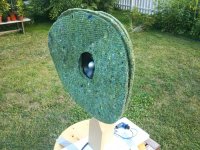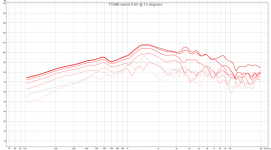It would sound the same as flush/soffit mounting?
No.
Regarding edge diffraction you may still have some as pointed by Allen, regarding baffle step it can't be the same as you won't radiate in 2 pi so no low end overall level increase ( in wall see the inverse of bsc: you've got a 'boost' in lowend you need to tame, inverse of what you experience with typical box).
It is interesting but does a material absorbing 'everything' above 500hz or 1khz exist?
I mean absorbsion is most always dependent of the angle the soundwave strike it. In this scenario i don't see how it is possible to achieve this.
Maybe from 1khz and up from Rockfon tiles ( but you'll need to make the driver protuberate 2cm from front baffle) but 500hz will be impossible ( you need some space behind the tiles to do that and overall thickness would be in the 20cm range, not so easy to mount the driver anymore).
I took the original question as hypothetical: "I'm talking enough dense, real wool felt to absorb >90% (or for the sake of argument, 100%) of the sound energy in the frequency band of interest"
Me too ScottJoplin.
My comment wasn't directed to anyone, just a thought about it.
Ps: my comment about angle of incidence is not true for all frequency bands but in mid/high it is.
My comment wasn't directed to anyone, just a thought about it.
Ps: my comment about angle of incidence is not true for all frequency bands but in mid/high it is.
Last edited:
It would sound the same as flush/soffit mounting?
No. Flush mounting eliminates baffle step by having a baffle that effectively extends to infinity. That means the baffle step frequency is effectively pushed down towards 0Hz.
A very absorptive baffle (or hanging individual drive units) would push the baffle step frequency up, probably until the directivity of the driver eliminates the effect.
@ Chris, isn't the faceplate itself a baffle?
By definition, no. The baffle is what the faceplate gets screwed to.
Acoustically, yes, I suppose. Having 100% absorption up to the edge of the diaphragm would be a very interesting speaker, but practicality demands somewhere to put the screws that hold everything together.
Chris
Duntech Sovereigns have baffle treatments made from very thick felt, applied very close to tweeter and midrange domes.
Sovereign - Duntech
cheers, Arthur.
Sovereign - Duntech
cheers, Arthur.
Because lower frequencies would extend forward away from the baffle and then curve around so any baffle treatment would have very little effect on them, unless it was absorbative enough? 😉 Hypothetical is just that 🙂
Last edited:
So the workings of a dome tweeter are fixed, and can be described, predefining our job at designing the baffle.but practicality demands somewhere to put the screws that hold everything together.
Maybe what baffle step is needs to be cleared up? In most “hifi” situations, it is an increase of output above 500 to 700 Hz because the radiation is supported by the baffle width. That can happen with a woofer/midrange, but also a dome tweeter. In my experience, it is practically impossible to absorb these frequencies without screwing the sound up. The flattest response for a woofer/midrange driver is usually with a large baffle. Tweeters like smaller and well rounded baffles.
Woofer/midranges get electrical filters (active or passive) and tweeters get generously rounded baffles.
I cannot imagine any thickness of felt helping with baffle step. It is generally used to prevent diffraction on the cabinet edges that would cause “phantom” images and screw imaging up.
Woofer/midranges get electrical filters (active or passive) and tweeters get generously rounded baffles.
I cannot imagine any thickness of felt helping with baffle step. It is generally used to prevent diffraction on the cabinet edges that would cause “phantom” images and screw imaging up.
That was also my interpretation of the question posed by the OP: what is effect on the baffle step. As shown by measurements by ollboll in thread pointed out by bradleypw, the diffraction is greatly reduced because the sound waves have different path lengths through the thick pads and destructive interference is reduced.I cannot imagine any thickness of felt helping with baffle step. It is generally used to prevent diffraction on the cabinet edges that would cause “phantom” images and screw imaging up.
Dipole wool carpet baffle experiment
No wool polars:
With wool polars:
It greatly reduced the dipole peak and smoothed the response, and it looks like the output below 1kHz increased and was flatter. Maybe this reduced the effect of the baffle step like a spherical baffle in effect?
Attachments
Last edited:
What about this variant: the driver is on the baffle, but there is no absorptive material directly around the driver. The absorptive material is still perfectly absorptive but is now located some inches away from the driver. Does the driver then radiate in half-space, transitioning to full-space as would be dictated by the "width" of the baffle that is not damped?The driver would act as if there's no baffle there.
Consider this: <snip>
Maybe this reduced the effect of the baffle step like a spherical baffle in effect?
Or a torus dipole? 🙂
Does the driver then radiate in half-space, transitioning to full-space as would be dictated by the "width" of the baffle that is not damped?
Yes, I would say so.
When you consider the absorption as a way of reducing the effective baffle size, this line of reasoning holds.
NB - we're still talking about a material that absorbs 100% of sound. YMMV.
Chris
In reality. low freq/long waves are practically impossible to absorb well. Damping works for tweeters, but contour tricks are needed for mid and woofer.
Hi,
Does that means that the mid and bass drivers couldn't be not flush mounted on the bafle even if it is flush after with high density foam or felt or corck above the wood front bafle?
(thickness around 3 to 0.5 mm to deal with with mid and bass driver when not flushed: dirctly screwed on the bafle-
Does that means that the mid and bass drivers couldn't be not flush mounted on the bafle even if it is flush after with high density foam or felt or corck above the wood front bafle?
(thickness around 3 to 0.5 mm to deal with with mid and bass driver when not flushed: dirctly screwed on the bafle-
Last edited:
In my view and experience edge/baffle diffractions happen above 2kHz, in upper band of mid(woofer)s.
It greatly reduced the dipole peak and smoothed the response, and it looks like the output below 1kHz increased and was flatter.
It's interesting the low frequencies could see the baffle though it's only made out of felt.
Felt vs. free air (no baffle) vs. solid baffle - we don't have much data, i recall only OllBoll Dipole wool carpet baffle experiment
it was a quite long thread but left me wondering...
it was a quite long thread but left me wondering...
I'm a bit confused with this thread as it seems to be jumping between 'baffle edge diffraction' and 'baffle step response'.
I've always assumed them to be different things (step response is where the wavelengths get larger than the baffle dimensions and the sound becomes more omnidirectional, with associated -6dB on axis drop in response), whereas baffle edge diffraction is to do with smaller wavelengths travelling along the baffle until they hit a 'sharp edge' and diffract off of it , causing a new independant (delayed) sound source in its own right.
I believe the felt treatments / roundovers are there to help with baffle edge diffraction, not sure what they'd do for baffle step response...
Rob.
I've always assumed them to be different things (step response is where the wavelengths get larger than the baffle dimensions and the sound becomes more omnidirectional, with associated -6dB on axis drop in response), whereas baffle edge diffraction is to do with smaller wavelengths travelling along the baffle until they hit a 'sharp edge' and diffract off of it , causing a new independant (delayed) sound source in its own right.
I believe the felt treatments / roundovers are there to help with baffle edge diffraction, not sure what they'd do for baffle step response...
Rob.
... jumping between 'baffle edge diffraction' and 'baffle step response'.
The same phenonomen, but they express differently based on the frequency and the (basically) width of the baffle.
dave
- Home
- Loudspeakers
- Multi-Way
- Baffle step when the baffle is nearly completely absorptive


